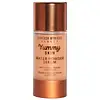Danessa Myricks Beauty Yummy Skin Water Powder Serum Versus Danessa Myricks Beauty Yummy Skin Blurring Balm Powder
What's inside
What's inside
 Key Ingredients
Key Ingredients

 Benefits
Benefits

 Concerns
Concerns

 Ingredients Side-by-side
Ingredients Side-by-side

Water
Skin ConditioningSilica
AbrasivePropanediol
SolventGlycerin
HumectantPyrus Malus Fruit Extract
Skin ConditioningHyaluronic Acid
HumectantKaolin
AbrasiveNiacinamide
SmoothingZinc PCA
HumectantSqualane
EmollientTremella Fuciformis Extract
HumectantGluconolactone
Skin ConditioningGalactoarabinan
Calcium Gluconate
HumectantPolyacrylate Crosspolymer-6
Emulsion StabilisingPotassium Sorbate
PreservativeEthylhexylglycerin
Skin ConditioningSodium Benzoate
MaskingAlumina
AbrasiveCI 77891
Cosmetic ColorantCI 77491
Cosmetic ColorantWater, Silica, Propanediol, Glycerin, Pyrus Malus Fruit Extract, Hyaluronic Acid, Kaolin, Niacinamide, Zinc PCA, Squalane, Tremella Fuciformis Extract, Gluconolactone, Galactoarabinan, Calcium Gluconate, Polyacrylate Crosspolymer-6, Potassium Sorbate, Ethylhexylglycerin, Sodium Benzoate, Alumina, CI 77891, CI 77491
Magnesium Carbonate
AbsorbentIsohexadecane
EmollientC13-15 Alkane
SolventIsododecane
EmollientDimethicone
EmollientSqualane
EmollientSynthetic Wax
AbrasiveSynthetic Candelilla Wax
EmollientKaolin
AbrasiveTocopheryl Acetate
AntioxidantLinum Usitatissimum Seed Oil
PerfumingZingiber Officinale Root Oil
MaskingHydrolyzed Sodium Hyaluronate
Skin ConditioningGlyceryl Behenate
EmollientLimnanthes Alba Seed Oil
Skin ConditioningMicrocrystalline Wax
Emulsion StabilisingPolyethylene
AbrasiveStearoxy Dimethicone
EmollientMagnesium Carbonate, Isohexadecane, C13-15 Alkane, Isododecane, Dimethicone, Squalane, Synthetic Wax, Synthetic Candelilla Wax, Kaolin, Tocopheryl Acetate, Linum Usitatissimum Seed Oil, Zingiber Officinale Root Oil, Hydrolyzed Sodium Hyaluronate, Glyceryl Behenate, Limnanthes Alba Seed Oil, Microcrystalline Wax, Polyethylene, Stearoxy Dimethicone
Alternatives
Ingredients Explained
These ingredients are found in both products.
Ingredients higher up in an ingredient list are typically present in a larger amount.
Kaolin is a clay. It is used for oil control and to help minimize pores. Like other clays, kaolin has the ability to absorb excess sebum or oil. This can help clean out pores and mattify the skin.
Some types of kaolin may have exfoliating properties. When water is added to kaolin, it becomes a paste with small abrasive particles.
Most kaolin is a white color, but may be pink/orange/red depending on where it comes from.
The name 'kaolin' comes from a Chinese village named 'Gaoling'. Kaolin clay comes from rocks rich in kaolinite. Kaolinite, the mineral, has a silicate layered structure. Kaolinite is formed from chemical weathering of aluminum siilicate minerals.
Besides skincare, kaolin is commonly used to make glossy paper, in ceramics, toothpaste, and as medicine to soothe stomach issues.
Learn more about KaolinSqualane is an emollient that helps the skin hold onto moisture. It's an oily liquid that occurs naturally in certain types of fish and plant oils.
Because squalane boosts hydration in the skin, it also comes with plenty of benefits: it is an antioxidant and can help fight free radicals and skin damage. Squalane is also found to have a detoxifying effect when applied.
Squalane comes from squalene, which occurs naturally within the sebum of our skin. It is one of the oils our skin produces to keep itself hydrated. Squalane is the hydrogenated version of squalene and has a longer shelf life.
Research shows that squalane is non-irritating (even at 100% concentration).
In general, it's a fantastic ingredient. It does a great job at hydrating the skin, and it's suitable for those with sensitive skin.
The source of squalane may impact malassezia / fungal acne. This is because olive oil derived squalane can contain impurities such as fatty acids and plant waxes. Sugarcane derived squalane is recommended for anyone with malassezia concerns.
Is squalane vegan?
This depends on the source. Squalane can be derived from both plants and animals. Most squalane used in skincare comes from plants.
Please note: the source of squalane is only known if disclosed by the brand. We recommend reaching out to the brand if you have any questions about their squalane.
Read more about squalene with an "e".
Is squalane an oil?
Squalane is often called an oil, but it’s technically not; it’s a hydrocarbon, meaning it’s only made of carbon and hydrogen, unlike true oils which are triglycerides made of fatty acids and glycerol.
The term “oil-free” isn’t regulated, so companies can define it however they want. Some exclude all oils, while others just avoid mineral oil or comedogenic oils.
While some people avoid oils thinking they cause breakouts, the right kind of oil (or oil-like ingredient like squalane) can actually help balance and hydrate your skin. It’s worth testing out simple oils or squalane to see what works best for your skin.
Learn more about Squalane